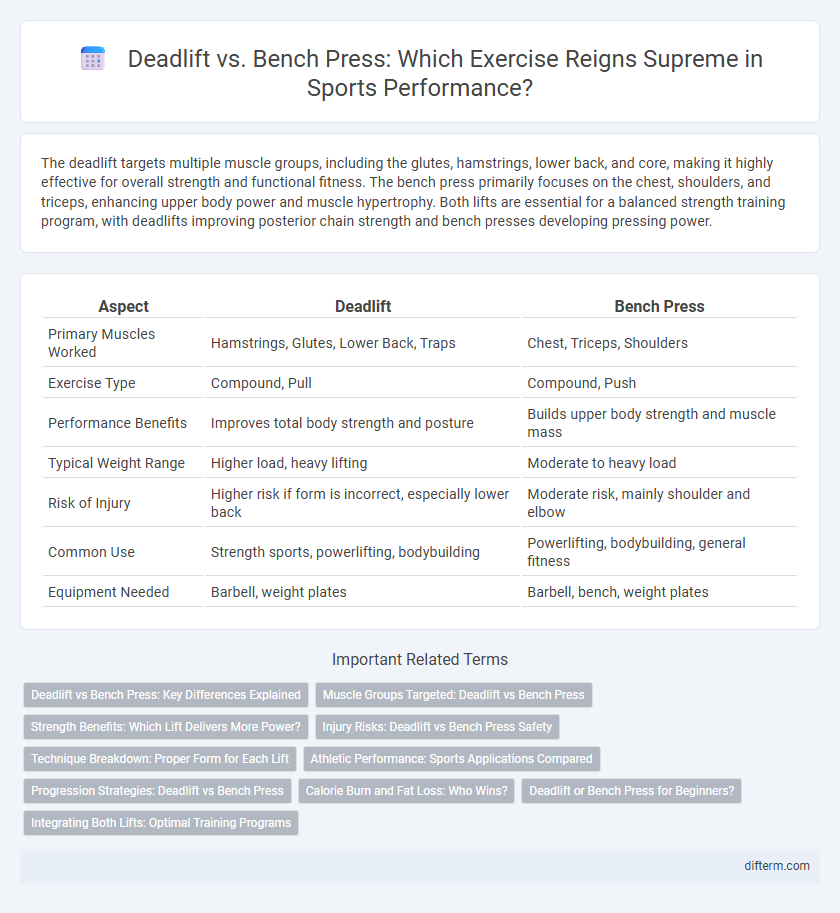The deadlift targets multiple muscle groups, including the glutes, hamstrings, lower back, and core, making it highly effective for overall strength and functional fitness. The bench press primarily focuses on the chest, shoulders, and triceps, enhancing upper body power and muscle hypertrophy. Both lifts are essential for a balanced strength training program, with deadlifts improving posterior chain strength and bench presses developing pressing power.
Table of Comparison
| Aspect | Deadlift | Bench Press |
|---|---|---|
| Primary Muscles Worked | Hamstrings, Glutes, Lower Back, Traps | Chest, Triceps, Shoulders |
| Exercise Type | Compound, Pull | Compound, Push |
| Performance Benefits | Improves total body strength and posture | Builds upper body strength and muscle mass |
| Typical Weight Range | Higher load, heavy lifting | Moderate to heavy load |
| Risk of Injury | Higher risk if form is incorrect, especially lower back | Moderate risk, mainly shoulder and elbow |
| Common Use | Strength sports, powerlifting, bodybuilding | Powerlifting, bodybuilding, general fitness |
| Equipment Needed | Barbell, weight plates | Barbell, bench, weight plates |
Deadlift vs Bench Press: Key Differences Explained
The deadlift primarily targets the posterior chain, including the glutes, hamstrings, and lower back, while the bench press emphasizes the pectoral muscles, triceps, and shoulders. Deadlifts engage more muscle groups overall, contributing to greater total body strength and functional movement, whereas bench presses focus on upper body power and muscle hypertrophy. Understanding these differences helps athletes choose the right exercise based on their strength goals and performance needs.
Muscle Groups Targeted: Deadlift vs Bench Press
The deadlift primarily targets the posterior chain, including the glutes, hamstrings, lower back, and traps, while also engaging core muscles for stability. The bench press focuses on the chest, specifically the pectoralis major, along with the anterior deltoids and triceps brachii. Both lifts complement each other by working different muscle groups essential for overall strength development and muscular balance.
Strength Benefits: Which Lift Delivers More Power?
The deadlift primarily targets the posterior chain, engaging muscles like the glutes, hamstrings, and lower back, which significantly enhances total body strength and power output. The bench press focuses on the upper body, developing the pectorals, deltoids, and triceps, critical for upper-body pushing strength and muscular endurance. For overall power development, the deadlift delivers a greater impact by recruiting multiple large muscle groups and promoting functional strength applicable to various athletic performances.
Injury Risks: Deadlift vs Bench Press Safety
Deadlifts pose a higher risk of lower back injuries due to the heavy load and spinal flexion involved, especially when performed with improper form. Bench presses commonly result in shoulder injuries, including rotator cuff strains and pectoral tears, often caused by excessive weights or poor technique. Both exercises require proper warm-up, controlled movement, and adherence to safety guidelines to minimize injury and ensure long-term joint health.
Technique Breakdown: Proper Form for Each Lift
The deadlift requires a hip hinge movement with a flat back, engaging the glutes, hamstrings, and lower back muscles while keeping the bar close to the shins. In contrast, the bench press demands a stable scapular retraction, tight grip, and controlled bar path targeting the chest, shoulders, and triceps. Mastering proper foot placement, breathing technique, and joint alignment is crucial for maximizing strength gains and preventing injury in both lifts.
Athletic Performance: Sports Applications Compared
Deadlift enhances overall athletic performance by building posterior chain strength, crucial for sports requiring explosive power and stability like football and track sprinting. Bench press primarily develops upper body pushing strength, benefiting sports focused on upper body power such as rugby and wrestling. Incorporating both lifts creates a balanced strength profile that supports varied athletic demands and injury prevention.
Progression Strategies: Deadlift vs Bench Press
Progression strategies for deadlift emphasize gradual increases in load with proper form to prevent injury, often incorporating variations like deficit or Romanian deadlifts to target specific muscle groups. Bench press progression prioritizes incremental weight increments combined with volume adjustments and accessory exercises such as close-grip bench press or dumbbell presses to strengthen supporting muscles. Monitoring recovery and technique refinement remains critical for both lifts to ensure consistent strength gains and minimize plateaus.
Calorie Burn and Fat Loss: Who Wins?
The deadlift engages more muscle groups, leading to higher calorie burn compared to the bench press, which primarily targets the chest and triceps. Research shows deadlifts can burn up to 50-100 calories per minute due to its full-body involvement, making it more effective for fat loss. For optimized calorie expenditure and fat reduction, deadlifts outperform bench presses in overall metabolic demand.
Deadlift or Bench Press for Beginners?
Deadlift and bench press target different muscle groups, with deadlifts engaging the posterior chain including the glutes, hamstrings, and lower back, while bench presses primarily focus on the chest, shoulders, and triceps. Beginners benefit from starting with deadlifts to develop overall strength and functional movement patterns, improving posture and core stability. Bench presses should be incorporated gradually to build upper body strength and muscle mass once foundational strength is established.
Integrating Both Lifts: Optimal Training Programs
Integrating both the deadlift and bench press in training programs maximizes overall strength development by targeting complementary muscle groups; deadlifts primarily engage the posterior chain while bench presses focus on the chest, shoulders, and triceps. Balanced routines incorporating these compound lifts improve muscular coordination, enhance functional fitness, and reduce injury risk through comprehensive load distribution. Athletes adopting periodized plans with progressive overload on both lifts achieve superior hypertrophy and power gains compared to specializing in a single movement.
deadlift vs bench press Infographic

 difterm.com
difterm.com